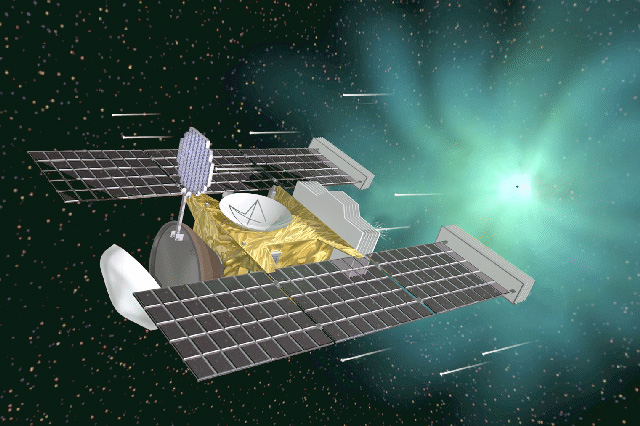Stardust: NASA's forgotten comet sampling probe
 |
| Credit: NASA |
- Launch Date: February 7, 1999
- Launch Site: Launch Complex 17 at Cape Canaveral Florida, United States
- Launch Vehicle: Delta II (7426 Lite variant with 4 strap-on SRBs)
- Mission Type: Flyby Sampler
- Target: (Stardust): Wild 2
- Target: (Stardust-NExT): Tempel 1
- Dimensions: (Main Bus): 1.6 Meters by 0.66 Meters
- Mass: 385 Kilograms (Including Propellant)
You can build your own Stardust spacecraft out of LEGO here.
The Stardust Mission
The Stardust spacecraft was a small spacecraft that NASA launched in 1999 to retrieve samples from the comet Wild 2 (Pronounced "Vilt" 2 after its swiss discoverer Paul Wild). Stardust would fly by the comet, and use a substance known as aerogel to obtain the particles. Aerogel is a super low density silica based substance that is inert and insulating. It was able to handle the impacts of cometary particles with ease, and bring them back to Earth without major chemical or physical alteration.
Stardust launched on February 7, 1999 aboard a Delta II rocket, after a day's delay. The spacecraft then entered an elliptical heliocentric orbit. Stardust made an Earth flyby on January 15, 2001, and boosted its aphelion to a radius of 2.7 astronomical units. On November 2, 2002, Stardust flew within 3300 kilometers of the asteroid 5535 Annefrank, and imaged it. This asteroid was named after the Jewish girl Anne Frank, who wrote a diary of her family's experiences during WWII and the German occupation. Stardust also sampled interstellar particles on its way to Wild 2.
On the 31st of December 2003, Stardust entered the coma of Wild 2. Soon after on January 2, the spacecraft made its closest approach of the comet, at 250 kilometres. Almost a year later on Christmas eve 2003, the probe deployed its sample collector. Six hours later the probe retracted the collector, and sealed the samples in the return capsule. During this time, the probe was able to obtain 72 images of the cometary nucleus.
The probe suffered 10 impacts that breached its outer shielding, but survived the encounter. Stardust's shielding, and that of many spacecraft, consisted of a Whipple shield. This type of shielding has an outer fabric layer that pulverizes the particles that impact it into countless tiny fragments. These fragments help to disperse the energy of the impact, leaving the inner shielding intact.
The spacecraft made it back to Earth in 2006, and the capsule separated on the 15th of January. Four hours later, the capsule entered the atmosphere. It deployed its main parachute at an altitude of around three kilometres, and touched down in the U.S. Air Force Test and Training Range in Utah. A storm had started brewing in the area, but the capsule made it through a window in the clouds. Strong winds from the storm blew the capsule slightly off course, but it was located with a beacon and a search helicopter.
 |
| Credit: NASA |
 |
| Credit: NASA |
Two days later, the capsule was transfered to a clean room at the Johnson Space Center in Houston, Texas. The capsule was opened, and the aerogel grid removed. The mothership spacecraft was diverted on its trajectory so it wouldn't collide with Earth. It was then put into hibernation mode until some future mission would find need of it.
The NExT Mission
The spacecraft commited another flyby of Earth on January 4, 2009, before the beginning of its next mission. A few years earlier, the Deep Impact mission sent an impactor into the comet Tempel 1, in order to learn about its composition. Stardust would fly by the comet to see what the impact looked like years later. This mission was dubbed the "New Exploration of Tempel 1 (NExT)".
 |
| Tempel 1 being impacted by Deep Impact's impactor. Credit: NASA |
Stardust flew by Tempel 1 at a distance of 181 kilometres on February 14, 2011. This both made Stardust the first probe to visit two comets, and Tempel 1 the first comet to be visited by two space probes (if you don't count the flurry of probes that went to investigate Halley's comet in the 80s, because most of them didn't get very close). The ejecta that was blasted out of Deep Impact's crater had fallen back in, and the crater was partially filled. This meant that the comet was much more loosely held together than had previously been believed. With this flyby, Stardust's missions had come to an end for real, and the spacecraft continues to orbit the Sun to this day. You can now see the Stardust return capsule at the National Air and Space Museum in Washington DC.
The Targets
 |
| Annefrank as seen by Stardust on its flyby. Credit: NASA |
- Date Discovered: March 23, 1942
- Designation: 5535 Annefrank (1942 EM)
- Class: Main-Belt Asteroid
- Radius: 2.4 Kilometres
- Rotational Period: 15.12 Hours
- Orbital Period: 1202 Days (3.29 Years)
 |
| Wild 2 as seen by Stardust on closest approach. Credit: NASA |
 |
| Composite image of Tempel 1 (pre-impact). Credit: NASA/JPL/UMD |





Comments
Post a Comment